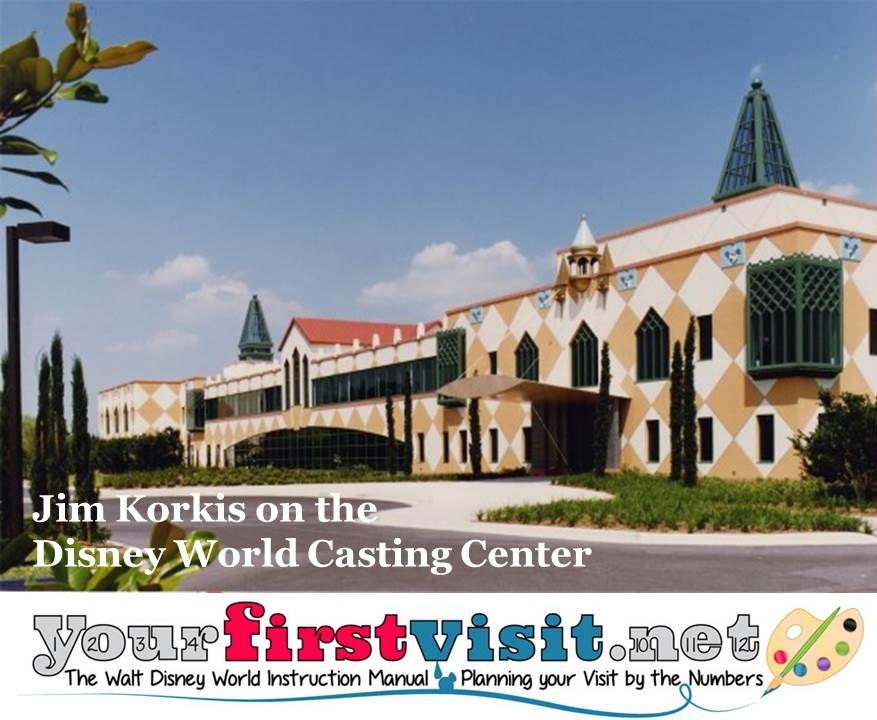Welcome back to Fridays with Jim Korkis! Jim, the dean of Disney historians and author of Jim’s Gems in The easy Guide, writes about Walt Disney World history every Friday on yourfirstvisit.net.
THE DISNEY WORLD CASTING CENTER
By Jim Korkis
Disney World staff are known not as employees, but rather as “cast members”—a constant reminder that they are part of a “show.” And where do cast members get their start? At the Casting Center near Disney Springs.
Architect Robert A.M. Stern designed the Walt Disney World Casting Center as an interpretation of the Doge’s Palace in Venice, Italy.
He began work on the project in 1987 and the Casting Center opened in 1989.
“You have to remember that Disney is a dream world rooted in a dream view of life and of architectural history,” stated Stern.
The Casting Center faces the busy I-4 freeway taking guests to the theme parks, and acts as whimsical castle-like billboard to attract employment applicants.
The building is approximately 61,000 square feet. The entrance is right across the street from Disney Springs (formerly Downtown Disney) so that it would be easy to locate.
The diamond patterns on the outside of the building hark back to the pattern found on the Italian harlequin, as well as being exaggerated references to the same triangular pattern on the exterior of the real Doge’s Palace, that was recreated at the Italian Pavilion in World Showcase.
The canopy awning and turrets and crenellation (notches) seem to resemble the traditional Disney castles. That airplane-wing like canopy over the entrance was actually taken from concept drawings for Tomorrowland.
The Mickey Mouse head-shaped cut-outs along the top of the building serve a practical purpose. They are scuppers, so when the rain comes, the water on the room drains through them.
The bronze doorknobs are re-creations of the famous doorknob in Disney’s animated feature Alice in Wonderland. The smiling doorknob is truly a Disney character, since he does not exist in Lewis Carroll’s original story.
After entering the building, a short walk leads to a small oval rotunda surrounded by 12 gold leaf-covered statues of Disney characters on pillars just as you might find sculptures on pillars in an Italian palace.
At this point, the only way you can turn is to the left, to ascend a ramp 150 feet long.
As you walk up the ramp, there are paintings on either side that once again mimic the murals that would be found in an Italian villa. However, the paintings on the side of the building facing the real world and paralleling I-4 depict unhappiness and road hazards. Even Mickey Mouse is getting a ticket from a police officer.
The paintings on the side of the building facing Walt Disney World property and your potential future as a cast member depict the Disney characters enjoying themselves tremendously at the parks, and even a smiling Walt Disney looking out on his dream that he never lived to see finished.
In addition to these murals, there are cracks on the wall and under the bridge. During the Renaissance, newly wealthy Italian families wanted to make their estates look old and ancestral, and so utilized the effect of trompe l’oeil (“fooling the eye”) of painting cracks and stains to create the illusion of looking antique.
From a distance these cracks look amazingly real, but they are flush with the wall. This imperfection is also designed to make the applicant feel more comfortable that not every thing at Disney is completely perfect.
The vaulted ceiling and natural lighting also provides relaxation through a sense of “openness.” And looking up, applicants can see Peter Pan flying toward Neverland, or in this case, a central receiving desk to guide them to the proper location.
The Walt Disney World Casting Center is just another example of clever Disney storytelling through architecture.
* * * * *
Thanks, Jim. Stern designed multiple buildings for Disney, including the Yacht Club and Beach Club. He noted that the purpose of the design of the casting center was “to clarify Disney’s hiring process and give it an architectural dimension.”
Come back next Friday for even more from Jim Korkis!
In the meantime, check out his books, including The Vault of Walt, Who’s Afraid of the Song of the South?, and The Book of Mouse
, and his contributions to The easy Guide to Your First Walt Disney World Visit, all published by Theme Park Press.
Follow yourfirstvisit.net on Facebook or Google+ or Twitter or Pinterest!!

Leave a Reply
Be the First to Comment!